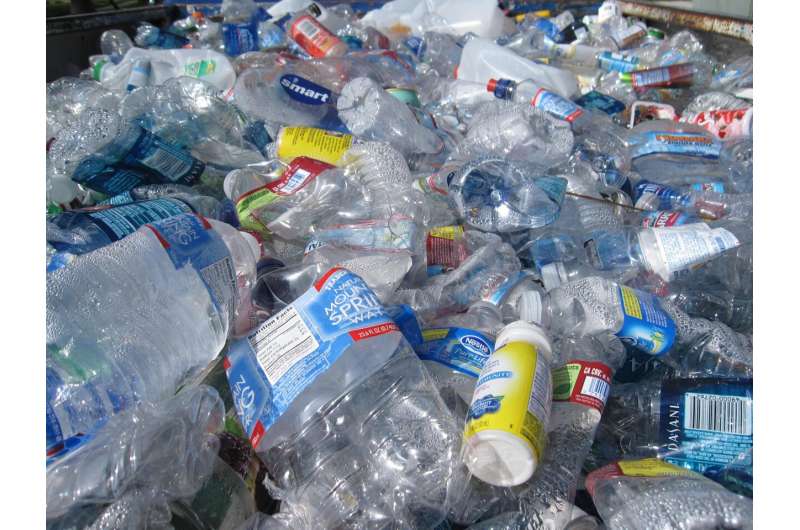This article has been reviewed according to Science X's editorial process and policies. Editors have highlighted the following attributes while ensuring the content's credibility:
fact-checked
trusted source
written by researcher(s)
proofread
Myths about plastic pollution are leading to public confusion: Here's why

Does the prediction that there could be "more plastic than fish in the ocean by 2050" concern you? How about reports that "we eat a credit card's worth of plastic per week"? These are some of the "facts" about plastic that are cited by the media.
They are certainly compelling sound bites and help to focus public and policy attention on the pressing topic of plastic pollution, but their scientific basis is far from robust.
The scientists whose findings were used to support the "more plastic than fish" claim refuted this. But one scientist who worked on the original source the estimation is based on has now updated his figures. The claim is further undermined by the assumptions the calculation is based on and an underestimate of fish stocks.
Research has also found that humans ingest less than a grain of salt of microplastics each week. This means that it would take around 4,700 years to ingest an amount of plastic equivalent to the weight of a credit card.
Over the past three years I've been interviewing households in the UK, Spain and Germany about plastics as part of a project focused on improving the recycling of plastic packaging. I've been struck by the level of confusion people have about the sources of and risks associated with plastic pollution.
So, in collaboration with the Hereon Institute of Coastal Environmental Chemistry and communications experts, I have launched an online resource called "Plastic Mythbusters" that aims to debunk popular plastic myths that regularly feature in media.
Negotiations are currently underway in Nairobi, Kenya, at the UN Environment Programme headquarters, to develop a legally binding global plastics treaty that covers the full life cycle of plastics—including their production, design, and disposal. The Scientists' Coalition for an Effective Plastics Treaty—a network of independent scientific and technical experts—is calling for decisions to be based on robust evidence.
The focus of the negotiations is understandably on research from the natural sciences. But what role does media play in shaping public and policy responses to the plastics crisis?
Images of plastic pollution
The images of plastic pollution that are sometimes used by media are emotive and powerful, reaching vast numbers of people. The BBC's Blue Planet II, which was broadcast worldwide in 2017, showed audiences the impact of plastic waste on the oceans through upsetting scenes. One scene depicted a pilot whale carrying her dead newborn calf, which narrator Sir David Attenborough said possibly died because the mother's milk had been poisoned with plastic.
Scenes such as these are now synonymous with plastic pollution. They can raise awareness of the problem and help to shape the discourse on environmental policy.
After Blue Plant II aired, online searches for "dangers of plastic in the ocean" increased by 100%. Michael Gove, UK environment secretary at the time, said he was "haunted" by images of the damage done to the world's oceans shown in the series and then introduced a series of proposals aimed at cutting plastic pollution.
However, there is no clear evidence in the Blue Planet II sequence that the mother's milk was actually contaminated with plastics. Imagery such as this can also promote the idea that plastic pollution is a problem far removed from our everyday lives and that our actions, whether it be dropping plastic litter or engaging in local clean up initiatives, will have little effect. There is still no robust evidence linking Blue Planet II to a sustained change in people's behaviors.
Sidelining issues
The way in which the media presents the issue of plastic pollution can shape the preference for certain solutions and sideline others. For instance, many people believe that the Great Pacific Garbage Patch—a large collection of marine debris in the North Pacific Ocean—is a solid mass. Framing the problem in this way assumes that plastic pollution can be removed from the ocean with the correct technology.
However, scientists describe the Great Pacific Garbage Patch as more akin to a "growing plastic smog" that does contain larger plastic items but is also composed of trillions of micro and nanoplastics spread over large distances.
Experts point out that technical fixes are not always the answer, particularly where plastic is spread over huge areas resembling a very thin "plastic soup". In such cases, technical fixes are less practical, especially when considering the continuous addition of more plastic due to unchecked production.
Power of media to set the agenda
There is a growing consensus advocating for investment in measures to curb plastic production, rather than investing in costly technical clean-up efforts. However, by emphasizing the individual responsibility of consumers to, for example, avoid single-use plastics, media coverage can divert conversations away from reducing plastic production.
The connection between plastics and climate change, or the impact of plastics on global biodiversity loss, are also not often covered by the media as much as emotionally charged images depicting marine animals entangled in plastics.
The original focus of the global plastics treaty was on marine litter, but it now encompasses the full life cycle of plastic pollution on all ecosystems. This includes plastic pollution in the atmosphere, and in marine, terrestrial and high altitude environments. This wider scope opens up the opportunity to explore public perceptions of the full life cycle of plastics.
The media is an invaluable resource that can play a key role in shaping how people perceive various issues. However, while it can effectively highlight the dangers of plastic pollution, there is a risk that an excessive reliance on emotive imagery may distract away from the policy that is actually needed.
Provided by The Conversation
This article is republished from The Conversation under a Creative Commons license. Read the original article.![]()




















